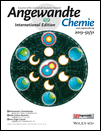Correspondence
Reply to the Correspondence on Microwave Effects in Organic Synthesis†
Prof. Dr. C. Oliver Kappe,
Corresponding Author
Prof. Dr. C. Oliver Kappe
Christian Doppler Laboratory for Microwave Chemistry (CDLMC) and Institute of Chemistry, Karl-Franzens-University Graz, Heinrichstrasse 28, 8010 Graz (Austria) http://www.maos.net
Christian Doppler Laboratory for Microwave Chemistry (CDLMC) and Institute of Chemistry, Karl-Franzens-University Graz, Heinrichstrasse 28, 8010 Graz (Austria) http://www.maos.netSearch for more papers by this authorProf. Dr. C. Oliver Kappe,
Corresponding Author
Prof. Dr. C. Oliver Kappe
Christian Doppler Laboratory for Microwave Chemistry (CDLMC) and Institute of Chemistry, Karl-Franzens-University Graz, Heinrichstrasse 28, 8010 Graz (Austria) http://www.maos.net
Christian Doppler Laboratory for Microwave Chemistry (CDLMC) and Institute of Chemistry, Karl-Franzens-University Graz, Heinrichstrasse 28, 8010 Graz (Austria) http://www.maos.netSearch for more papers by this author†
This work was supported by a grant from the Christian Doppler Research Society (CDG). B. Pieber and Dr. D. Dallinger are thanked for their critical input to this manuscript.
Graphical Abstract
References
- 1C. O. Kappe, B. Pieber, D. Dallinger, Angew. Chem. 2013, 125, 1124;
10.1002/ange.201204103 Google ScholarAngew. Chem. Int. Ed. 2013, 52, 1088.
- 2
- 2aN. Kuhnert, Angew. Chem. 2002, 114, 1943;
10.1002/1521-3757(20020603)114:11<1943::AID-ANGE1943>3.0.CO;2-P Google ScholarAngew. Chem. Int. Ed. 2002, 41, 1863;10.1002/1521-3773(20020603)41:11<1863::AID-ANIE1863>3.0.CO;2-L CAS PubMed Web of Science® Google Scholar
- 2bC. R. Strauss, Angew. Chem. 2002, 114, 3741;
10.1002/1521-3757(20021004)114:19<3741::AID-ANGE3741>3.0.CO;2-E Google ScholarAngew. Chem. Int. Ed. 2002, 41, 3589.10.1002/1521-3773(20021004)41:19<3589::AID-ANIE3589>3.0.CO;2-Q CAS PubMed Web of Science® Google Scholar
- 3For additional reading on this topic published after the appearance of our Essay, see: C. O. Kappe, Acc. Chem. Res. 2013, DOI: .
- 4M. R. Rosana, Y. Tao, A. E. Stiegman, G. B. Dudley, Chem. Sci. 2012, 3, 1240.
- 5G. B. Dudley, A. E. Stiegman, M. R. Rosana, Angew. Chem. 2013, DOI: ; Angew. Chem. Int. Ed. 2013, DOI: .
- 6
- 6aW. Huang, R. Richert, J. Phys. Chem. B 2008, 112, 9909; W. Huang, R. Richert, J. Chem. Phys. 2009, 130, 194509.
- 7Since there is no precedent in the literature on microwaves in organic chemistry for this type of effect, the classification is not as straightforward as it appears. Even though several previous reports mention the term “molecular radiator” (see Ref. [6] in the Dudley Correspondence) the concept is not discussed in any further detail in these publications. We received conflicting opinions from the referees on how to best classify the effect demonstrated by Dudley and co-workers, but ultimately considered this to be a specifc microwave effect in our Essay.
- 8Arguments pertaining to the pre-exponential factor A and the Arrhenius law in the context of microwave effects are typically discussed in the context of nonthermal microwave effects. See for example: L. Perreux, A. Loupy, A. Petit in Microwaves in Organic Synthesis, 3rd ed. ), Wiley-VCH, Weinheim, 2013, chap. 4, pp. 127–208.
10.1002/9783527651313.ch4 Google Scholar
- 9E. Richards, Chem. World 2012, March issue, p. 25.
- 10For definitions and examples for thermal, specific, and nonthermal microwave effects in organic chemistry, see:
- 10aC. O. Kappe, Angew. Chem. 2004, 116, 6408;
10.1002/ange.200400655 Google ScholarAngew. Chem. Int. Ed. 2004, 43, 6250;
- 10bC. O. Kappe, A. Stadler, D. Dallinger, Microwaves in Organic and Medicinal Chemistry, 2nd ed., Wiley-VCH, Weinheim, 2012, chap. 2, pp. 9–39.
10.1002/9783527647828.ch2 Google Scholar
- 11
- 11aC. O. Kappe, Chem. Soc. Rev. 2008, 37, 1127;
- 11bC. O. Kappe, D. Dallinger, S. S. Murphree, Practical Microwave Synthesis for Organic Chemists—Strategies, Instruments, and Protocols, Wiley-VCH, Weinheim, 2009;
10.1002/9783527623907 Google Scholar
- 11cC. O. Kappe, A. Stadler, D. Dallinger, Microwaves in Organic and Medicinal Chemistry, 2nd ed., Wiley-VCH, Weinheim, 2012.
10.1002/9783527647828 Google Scholar
- 12In rare instances we have performed microwave irradiation experiments in power-control mode, mainly to investigate the arcing behavior of metals under different electric field strengths. For details, see:
- 12aB. Gutmann, A. M. Schwan, B. Reichart, C. Gspan, F. Hofer, C. O. Kappe, Angew. Chem. 2011, 123, 7778;
10.1002/ange.201100856 Google ScholarAngew. Chem. Int. Ed. 2011, 50, 7636;
- 12bW. Chen, B. Gutmann, C. O. Kappe, ChemistryOpen 2012, 1, 39.
- 13The measurement of forward and reflected microwave power is typically only implemented in industrial-scale microwave devices, which also allows the determination of an energy balance. See for example: R. Morschhäuser, M. Krull, C. Kayser, C. Boberski, R. Bierbaum, P. A. Püschner, T. N. Glasnov, C. O. Kappe, Green Process. Synth. 2012, 1, 281.
- 14J. Robinson, S. Kingman, D. Irvine, P. Licence, A. Smith, G. Dimitrakis, D. Obermayer, C. O. Kappe, Phys. Chem. Chem. Phys. 2010, 12, 4750.
- 15References [23] and [24] in our Essay point the reader to the Supporting Information for full experimental details and an extended discussion. Therefore the discussion provided in the Supporting Information is an integral part of the Essay and cannot be considered separately from the main body of the Essay.
- 16For seminal references on microwave superheating effects at atmospheric conditions, see:
- 16aD. R. Baghurst, D. M. P. Mingos, J. Chem. Soc. Chem. Commun. 1992, 675;
- 16bR. Saillard, M. Poux, J. Berlan, M. Audhuy-Peaudecerf, Tetrahedron 1995, 51, 4033;
- 16cF. Chemat, E. Esveld, Chem. Eng. Technol. 2001, 24, 735.
- 17For selected references from our laboratory on reinvestigating microwave effects, see Refs. [10–13], and [17–19] in our Essay (Ref. [1]).
- 18C. O. Kappe, Chem. Soc. Rev. 2013, 42, 4977.
- 19We note that in their Correspondence, Dudley and co-workers did not respond to some of our general criticism of their experimental work, in particular the questionable NMR analysis, lack of statistical analysis of data, and some rather difficult to rationalize microwave hardware issues. For example, while the authors were able to heat a 2 mL reaction mixture to 80 °C using 88 W of average microwave power, they were unable to heat the same reaction mixture on the same instrument to 100 °C using 200 W or 300 W magnetron output power. This is rather difficult to comprehend.





